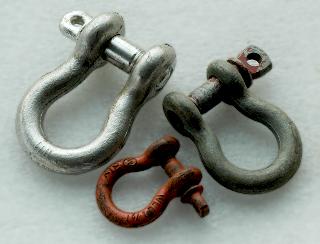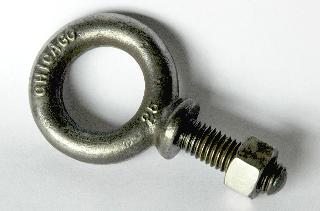Rigging
When moving and transporting heavy loads rigging of various types is needed.
Rigging to move loads in the shop, rigging to lift loads and rigging to tie loads down on your truck.
Basic rigging tools for moving include rollers, wedges, pry bars, jacks, chain, straps, eye bolts and shackles.
Rollers
Machinery moving rollers vary in size but for the small shop 3/4" pipe (1.05" dia.) work well.
A set of seven about three feet long can be cut from a 20 foot pipe.
To move things a minimum of two rollers are needed but three or four are better.
For large heavy things you may need more but in general the less rollers you use the easier the move.
To move small things two rollers can be faster and most efficient.
The load is wedged or pried up until a roller can be gotten under it.
The load is rolled to the balance point and another roller put under the leading edge of the load.
Then the load is rolled until the second rolled is at the balance point and the load tipped to remove the trailing roller and move it to the front.
This is often easier than trying to get the load started on new rollers at the front over and over.
It is also easier than having too many rollers and constantly shifting them.
With three rollers the load stays on two rollers and the trailing roller is shifted to the front as the load comes off of it.
If the load is long or on springy skids, or extremely heavy more rollers may be necessary.
Loads over 4,000 pounds can flatten 3/4" schedule 40 rollers into an oval which will not roll.
For heavy loads schedule 80 (extra strong) pipe is better to use.
Wedges
Wedges are rarely needed but can be handy.
Steel wedges should be less than 10 degrees taper and need to have hardened and tempered edges.
SAE 4140 would make good machinery wedges.
Steel wedges are used for initial lifting of a machine until pry bars or larger wedges can be installed.
Wedges are also used for leveling machines.
Wooden wedges can be useful for supporting loads or removing rollers and leaving the load raised to make it easier to move later.

Pry Bars
There are numerous types of pry bars and each is useful when moving machinery.
Pinch bars or "Rail Road bars" are the best tool for most heavy moving jobs.
These are about 1-1/4" square on the wedge end and are about five feet long.
These are forged in a long taper to reduce weight.
One will do most jobs and two may be useful for a large crew.
Wrecking bars are handy for initial lifts and bumping small loads along.
These come in lengths from 24 to 36" long.
The shorter ones are handy in tight places and the longer for heavy loads.
It is good to have several to make space for larger pry bars.
Flat carpenter's pry bars are not very useful when moving machinery but are needed for opening crates, pulling nails and so on.

Jacks
These are occasionally needed to raise loads for moving.
Hydraulic jacks are best for lifting loads, screw jacks for holding loads.
If you have a truck, even a heavy pickup and you move machinery you need a hydraulic jack if you have a flat tire.
While a scissors jack, even heavy ones will lift a small load they do not do well with heavy loads.
You should have one good hydraulic jack of 5 tons or better in your kit.
For safety it is also good to have a square flat piece of framing lumber (2 x 10 or 2 x 12) for a load distribution pad to put under the jack on soft ground
Chain
Chain comes in many varieties and sizes.
Common hardware chain with straight sides is not load chain.
Load chain has arched sides that spring under high load.
5/16" and 3/8" are common sizes for load chain used to tie loads down on trucks and move light loads.
Rigging chain should be equipped with proper sized hooks.
Chain hooks have a straight slot that just fits the chain and is used to make fixed loops and connect pieces of chain.
Grab hooks are open, fit onto and make sliding loops on chain.
Chains can be made up with one or both type hooks.
It is also possible to put two hooks on one end of chains and make them more flexible in use.
Chains used in trucks need load binders that fit your chains.
You need to purchase chain, binders and other rigging to work together.
Chain, load binders and good anchors such as eye-bolts are the best way to tie down a load in a truck.
Straps or Slings

Nylon slings come in various weights and qualities.
Commercial load slings with loop ends have high capacities for their weight.
Being soft they do not mar objects being lifted.
I have a pair four feet long and one inch wide that will lift over a ton each.
Our shop also had 2" straps that could lift 16,000 pounds or more each.
Other synthetic slings are made of many polyprolene strands or cordage housed in a woven sleeve.
These are softer than the hard nylon slings.

Slings have the advantages of cable (wire rope) without the disadvantages of weight,
kinks and loose wires that can puncture gloves and skin.
The little one inch double ply nylon sling above has a capacity of 2500 lbs. - choker, 3200 lbs. - straight and 6400 lbs. - sling.

Shackles
Load shackles are a key element in rigging and lifting loads and usually a necessity when using straps.
Small shackles are used to connect chain and slings, large shackles to connect rigging to hoists.
Larger ones (5/8" and 3/4" pin) are generally handier for all purpose rigging.
LEFT: 3/4", 5/8" and 1/2" Shackles.
The large one is stainless, the grey is galvanized.
Capacity in Pounds
Forged Steel Shouldered Pattern Eye-bolts |
| Size |
Number |
Vert Cap |
Cap at 45° |
Cap at 90° |
| 1/4" |
21 |
500 |
125 |
100 |
| 5/16" |
22 |
900 |
225 |
180 |
| 3/8" |
23 |
1,300 |
325 |
260 |
| 7/16" |
24 |
1,800 |
450 |
360 |
| 1/2" |
25 |
2,400 |
600 |
480 |
| 9/16" |
26 |
3,000 |
750 |
600 |
| 5/8" |
27 |
4,000 |
1,000 |
800 |
| 3/4" |
28 |
5,000 |
1,250 |
1,000 |
| 7/8" |
29 |
7,000 |
1,750 |
1,400 |
| 1" |
30 |
9,000 |
2,250 |
1,800 |
| 1-1/8" |
31 |
10,600 |
2,650 |
2,120 |
| 1-1/4" |
32 |
13,400 |
3,350 |
2,680 |
| 1-1/2" |
33 |
19,600 |
4,900 |
3,920 |
| Data from Chicago Machinery catalog 1986 - jdd |
|
Eye Bolts
Lifting eyes are heavy forged pieces of hardware, not bent open sided or welded eyes.
Bent hardware store eyes should NEVER be used for lifting purposes.
Lifting eyes have a large flange under the eye and some are threaded and others are designed for welding.
Threaded eyes have relatively long threaded shanks and large fillets under the flange that require special drilled, tapped, counter bored and chamfered holes.
When used as a through bolt a plain washer and heavy nut should be used.
The capacity of an eye bolt is maximum in a straight upward pull and derated as the angle of pull decreases from axial.
I have saved and converted old eye bolts with stripped or bent shanks to welding as the only difference between threaded and welded is the threaded shank.
Stainless lifting hardware has only 60% of the lifting capacity of standard steel hardware.

Used Rigging (second hand) and Safety Inspection
Used rigging is often rigging that has been scraped by industry due to failure to pass inspection.
Chain wears out, gets kinked, overloaded, cracked, arc burned. . .
Synthetic fiber slings get nicked, torn, and overloaded.
Hooks over loaded and bent. Cables kinked, frayed or crimp splices damaged.
All of these are reasons for rigging to be scrapped and end up in the junk yard.
They are good reasons for you NOT to buy.
In a small business YOU are your own rigging inspector.
It is up to you what rigging is suitable to be used.
In industry the rules are usually black and white, good or bad.
In the small shop there are shades of grey.
In the small shop you may have chain that is used for pulling or tie down but not lifting, slings that are nicked but so highly over rated for your purposes that you can get by with them.
These are your safety decisions.
Note that many synthetic fiber slings have black or red warning threads sewn into them.
When the sling has been overloaded and stretched beyond the safe use point these threads break and the sling should be discarded.
In industry they normally cut damaged rigging into pieces so that others will not be tempted to reuse it.








When dealing with heavy loads there is always risk. Your goal is to minimize this risk as much as possible.
The most important thing to remember is that heavy items have mass and mass equals energy. It may not be obvious but you know if you drop something heavy on your foot it will hurt. But it may do more than hurt. An anvil, swage block or milling vise dropped on one's foot could break numerous bones, disable and cause considerable expense.